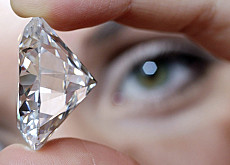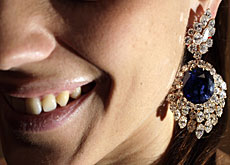Diamond dazzles at Swiss auction

The centrepiece of this week's jewellery and watch auctions in Geneva, a 84.37-carat white diamond, has been sold for just under SFr18.2 million ($16.2 million).
Sotheby’s had valued the jewel – the largest top-quality, brilliant-cut white diamond ever to go under the hammer – at SFr15-20 million.
The winning bid on Wednesday made the diamond the second most expensive stone or piece of jewellery ever sold at auction, falling just short of the $16.5 million fetched by the 100.1-carat “Star of the Season” diamond at the same Sotheby’s branch in Geneva in May 1995.
The purchase was made by telephone by Guess clothing company founder Georges Marciano, who named the diamond “Chloe” after his 12-year-old daughter.
“In 32 years, it was this stone that had the ability to take my breath away,” said David Bennett, Sotheby’s head of jewellery for Europe and the Middle East. “It had so much life and brilliance.”
Bennett identified the seller, whose name had been withheld before the auction, as Ron Cohen, the owner of the Los Angeles-based Clean Diamonds.
Cohen said he purchased it from Angola’s national diamond company two years ago, and knew immediately he had found something special.
“The size and especially the quality of the rough material was extraordinary,” he added. “I only hope I will one day come across another stone like that one.”
Excellent grades
The diamond – showcased in Hong Kong, Paris, New York, Rome, Los Angeles, London, Dubai and Bahrain before the auction – received the highest possible grading, Sotheby’s said.
It is D-colour, or finest white, has flawless clarity and its cut, polish and symmetry have all been graded excellent.
The brilliant-cut is notoriously difficult to obtain from rough crystal. It brought the highest price per carat for a white diamond at auction, $191,980, according to Sotheby’s.
Bennett said the Kimberly Process aimed at combating blood diamonds was respected at every stage for the gem.
Some 300 collectors, gem manufacturers and those just curious packed a salon in Geneva’s historic Beau Rivage hotel for the sale, which pulled in just under SFr64 million in total.
A fancy, vivid blue diamond ring sold for over SFr5.3 million, beating the high-end estimate, as did a marquise-shaped diamond ring by Cartier that fetched more than SFr2.6 million.
Sotheby’s said it sold 307 lots, against 78 unsold. “We had interest from all over the world,” Bennett said. “This sale said a lot about the jewellery market internationally, especially the diamond market. It says great things about jewels.”
The overall sale makes 2007 Sotheby’s strongest year for jewellery since 1995, he added.
It comes only a week after disheartening results from the New York-based company’s Impressionist and Modern Art auction, which sent Sotheby’s stock tumbling.
That sale last week fetched $269.7 million, well short of estimates, and led some analysts to speculate whether the flight from risk currently gripping financial markets may be spilling over into the art world.
swissinfo with agencies
Geneva has been a major centre for auctions since 1968, especially for jewellery and watches.
At a separate auction in Geneva on Thursday organised by Christie’s, a rare purplish-red diamond ring sold for SFr2.97 million ($2.6 million), setting a world record for a red diamond. The octagonal stone weighed 2.26 carats and was the largest red diamond to appear at auction.
Last spring, sales of watches, jewellery and fine wines were worth more than SFr140 million.
Conflict diamonds, also known as “blood” diamonds, are rough diamonds used to finance armed conflict, mainly in Africa.
Ivory Coast is the only country subject to United Nations sanctions over diamonds. In Angola, Sierra Leone, the Democratic Republic of Congo, all affected by blood diamonds in the past, the situation remains fragile.
The Kimberley Process, which was drawn up in Interlaken, Switzerland, is an international certification scheme that regulates the trade in rough diamonds. Its aim is to prevent the trade in conflict diamonds, while helping to protect the legitimate trade.
There are 46 participants representing 71 countries (including the 27-member European Union as one participant) accounting for an estimated 99.8% of the global rough diamond trade. All major rough diamond producing, exporting and importing countries – including Switzerland – belong to the Kimberley Process.

In compliance with the JTI standards
More: SWI swissinfo.ch certified by the Journalism Trust Initiative


You can find an overview of ongoing debates with our journalists here. Please join us!
If you want to start a conversation about a topic raised in this article or want to report factual errors, email us at english@swissinfo.ch.